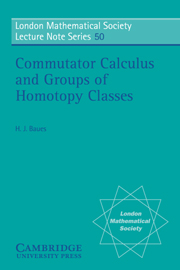Introduction to Part B
Published online by Cambridge University Press: 13 March 2010
Summary
An inexhaustible source of algebraic topology is the homotopy classification problem. If we have a space we would like to know a list of algebraic invariants which determine the homotopy type of the space. If we have a map we would like to characterize the map up to homotopy by algebraic invariants. Moreover, if the set of homotopy classes [X, G] is a group, for example if G is a topological group, we would like to determine the group structure of the set as well. Helpful tools for these problems are functors from the topological category to an algebraic category like homology, cohomology, homotopy groups etc. However, the known functors give us only rather crude algebraic pictures and almost nothing is known about the image categories of these functors.
There are two opposite directions in which the problem can be pursued, namely rational homotopy theory and stable homotopy theory. Both are studied with great energy. Indeed, research camps seem to have formed - on one side of the front are those mathematicians who think a rational space is the most natural object, on the other side those for whom a spectrum is the most natural object to start with. At the time of J. H. C. Whitehead people were interested in finite polyhedra. Soon they realized that the calculation of homotopy groups of spheres is a deep and fundamental obstacle to solving the classification problems. Rationally these groups were computed by Serre.
- Type
- Chapter
- Information
- Publisher: Cambridge University PressPrint publication year: 1981



